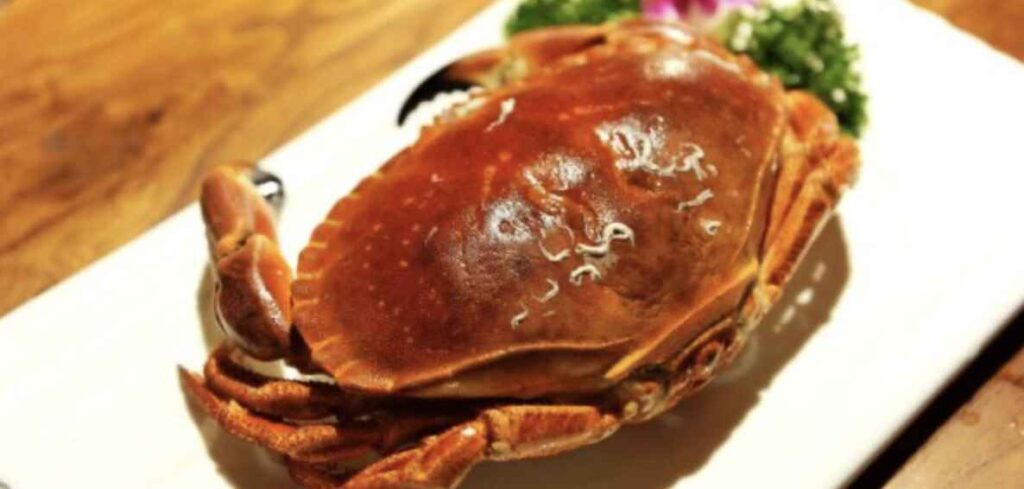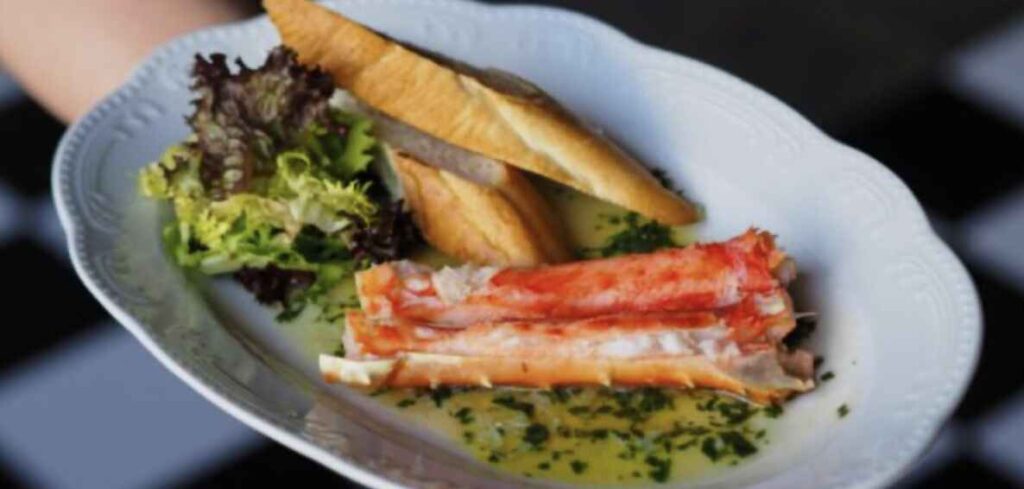The Dungeness crab (Metacarcinus magister) is a species of crab found along the western coast of North America, from Alaska to California. Known for its sweet and tender meat, it is a prized delicacy and an integral part of coastal seafood cuisines. Below is an overview of its habitat, characteristics, lifecycle, and culinary significance.
Table of contents
Understanding Dungeness Crab
Habitat and Distribution
Dungeness crabs inhabit the sandy and muddy bottoms of coastal bays and estuaries. They thrive in cold, shallow waters, usually ranging from intertidal zones to depths of about 600 feet. These crabs are particularly abundant in the Pacific Northwest, where commercial fishing is a significant industry.
Physical Characteristics
- Size: Adult Dungeness crabs typically measure 6 to 10 inches across the carapace (shell).
- Color: They are generally a light reddish-brown with purplish highlights.
- Shape: The carapace is broad and oval-shaped, with five distinct spines on each side.
- Legs: They have five pairs of legs, with the front pair featuring sharp pincers.
Lifecycle
- Reproduction: Mating occurs in late spring and early summer, with females storing sperm to fertilize eggs later.
- Larval Stage: After hatching, larvae drift in plankton-rich waters before settling on the ocean floor.
- Growth: Dungeness crabs grow through molting, shedding their exoskeletons multiple times as they increase in size.
- Lifespan: They typically live for 8–13 years.
Ecological Role
Dungeness crabs play a vital role in the marine ecosystem:
- Predators: They feed on clams, smaller crustaceans, and fish.
- Prey: Juveniles and adults are prey for larger species, including fish, octopuses, and sea otters.
Culinary Importance
Dungeness crab is a sought-after seafood item, celebrated for its:
- Flavor: Sweet, delicate meat that is versatile in cooking.
- Culinary Uses: Commonly steamed, boiled, or served in dishes like crab cakes, bisques, or salads.
- Seasonality: Peak harvesting occurs during the winter months, aligning with the legal fishing season to ensure sustainability.
Sustainability and Conservation
Efforts are in place to manage Dungeness crab populations:
- Fishing Regulations: Strict size limits, catch quotas, and seasonal closures help prevent overfishing.
- Habitat Protection: Conservation programs aim to protect breeding grounds and minimize environmental impact.
The Dungeness crab is not just a culinary treasure but also a species of ecological and economic importance. Understanding its biology and role in the ecosystem underscores the need for sustainable practices to preserve this iconic crustacean for future generations.
What Makes Dungeness Crab Special?
How to Select Fresh Dungeness Crab

Here’s the revised content with simplified language for better readability:
Dungeness Crab: A Delicious and Unique Seafood Favorite
Dungeness crab is a standout for its amazing taste, nutritional benefits, and importance to the environment. Here’s what makes it special:
1. Delicious Taste and Versatile Cooking
Sweet, Tender Meat: Dungeness crab is loved for its slightly sweet and soft meat, making it perfect for fancy dishes or casual meals.
Works in Many Recipes: From crab boils to crab cakes and soups, its flavor works well with many types of cooking.
2. Packed with Nutrition
Rich in Protein: A great source of lean protein, it helps build and repair muscles.
Low in Fat: Naturally low in fat and calories, it’s a healthy choice for any diet.
Full of Nutrients: It’s loaded with important vitamins like B12, zinc, and omega-3s, which are good for your brain, heart, and immune system.
3. Unique Habitat and Growth
Lives on the Pacific Coast: Found along North America’s Pacific coastline, it’s tied to the culture and economy of the area.
Grows by Molting: Dungeness crabs grow by shedding their shells and forming new, larger ones.
4. Important to the Environment
Key Part of the Ecosystem: As both a hunter and prey, Dungeness crabs help keep marine life balanced.
Sign of a Healthy Coastline: Their presence shows the ecosystem is thriving and well-maintained.
5. Sustainable and Well-Managed
Sustainable Fishing: Strict rules like size limits, catch limits, and seasons keep crab populations healthy.
Supports Local Communities: The crab industry provides income for coastal towns while following conservation practices.
6. Cultural Importance
Iconic in Local Food: A key part of Pacific Northwest cooking, it’s celebrated at crab festivals and community events.
Deep Historical Roots: Indigenous communities have valued Dungeness crab as a food source for generations, making it part of their traditions.
This version simplifies the language while keeping the content engaging and informative.
- Live Crabs: Choose active, responsive crabs with hard shells for meaty quality.
- Pre-Cooked Crabs: Look for bright orange-red shells and a clean, ocean-like aroma.
- Freshness Check: Avoid crabs with a strong fishy smell.
- Reputable Source: Purchase from trusted seafood markets for quality assurance.
- Weight: Heavier crabs typically contain more meat.
Cleaning and Prepping the Crab
Before cooking, it’s crucial to clean and prep the Dungeness crab properly. Start by rinsing the crab under cold running water to remove any debris. If desired, you can remove the top shell and clean out the internal organs, including the gills and intestines. This step ensures your crab is ready for cooking and enhances its flavor and presentation.
Tools You’ll Need for Cooking
To cook Dungeness crab effectively, you’ll need basic tools such as a large stockpot, steaming rack, tongs, a sharp knife, and a crab cracker. These tools simplify the process and help you achieve the best results with minimal hassle. Having everything ready before you start can make your cooking experience smooth and enjoyable.
Best Methods to Cook Dungeness Crab
Steaming: A Classic Method
Steaming is a popular way to preserve the delicate flavor and texture of Dungeness crab. It’s a straightforward technique that requires minimal ingredients, making it a favorite among seafood lovers.
Step-by-Step Guide to Steaming
- Fill a large pot with about 2 inches of water and bring it to a boil.
- Place a steaming rack in the pot and arrange the crabs on the rack.
- Cover the pot and steam the crabs for 15-20 minutes until their shells turn a bright orange.
- Remove the crabs and let them cool slightly before serving.
Boiling: Quick and Simple
Boiling is a fast and easy method that infuses the crab with subtle flavors from the cooking liquid. It’s ideal for cooking multiple crabs at once.
Step-by-Step Guide to Boiling
- Fill a large pot with water and add salt or spices to taste.
- Bring the water to a rolling boil and add the crabs.
- Cook for 12-15 minutes until the shells are vibrant orange.
- Remove the crabs, drain them well, and serve hot.
Grilling for a Smoky Flavor
Grilling adds a smoky, caramelized taste to Dungeness crab, making it a fantastic option for those who love bold flavors.
How to Grill Dungeness Crab
- Preheat your grill to medium-high heat.
- Brush the crab with olive oil or butter and season with spices.
- Also, Grill the crab for 4-5 minutes on each side until lightly charred.
- Serve immediately with your favorite dipping sauce.
Enhancing the Flavor
Seasoning and Marinades
Enhance the natural sweetness of Dungeness crab with simple marinades like garlic butter, lemon, and herbs. Further more, you can Leave the crab soak in the marinade for a few minutes before cooking to intensify the flavors.
Sauce Pairings for Dungeness Crab
Pair your crab with sauces like melted garlic butter, spicy aioli, or tangy citrus vinaigrette. These sauces elevate the taste and complement the crab’s rich texture.
Serving Suggestions
Plating Like a Pro

Arrange the crab on a large platter with garnishes like fresh parsley, lemon wedges, and edible flowers for a restaurant-quality presentation. Use colorful serving dishes to make the meal visually appealing.
Side Dishes That Complement
Pair Dungeness crab with sides like garlic bread, roasted vegetables, or a fresh green salad. These accompaniments balance the richness of the crab and round out the meal.
Common Mistakes to Avoid When Cooking
Overcooking or Undercooking
Cooking Dungeness crab for too long or too short a time can ruin its texture and flavor. Always follow recommended cooking times to achieve perfect results.
Ignoring Freshness
Using old or improperly stored crabs can result in an unpleasant taste. Always select fresh crabs with a clean, briny smell and vibrant shells.
Storing and Reheating Dungeness Crab
Proper Storage Techniques
Store cooked crab in an airtight container in the refrigerator for up to three days. For longer storage, freeze the crab meat in a sealed bag or container.
Tips for Reheating Without Losing Flavor
Reheat crab gently by steaming or microwaving it with a damp paper towel to retain moisture. Avoid high heat, which can dry out the meat.
Frequently Asked Questions About Cooking Dungeness Crab
From selecting the freshest crab to mastering cooking techniques, FAQs can guide you through every step of preparing this delicious seafood. Knowing the answers ensures a stress-free and flavorful cooking experience.
How to Best Cook Dungeness Crab
Dungeness crab is a delicacy that can be cooked using a variety of methods, including steaming, boiling, and grilling. Each technique offers unique flavors and textures, allowing you to tailor the dish to your taste preferences. Follow these steps to prepare and enjoy this seafood favorite.
Steaming Dungeness Crab
Steaming is ideal for preserving the crab’s natural sweetness. It’s simple and requires minimal ingredients. Follow this step-by-step guide to steaming to achieve perfectly cooked crab every time.
Boiling Dungeness Crab
Boiling is a quick and efficient method that works well for infusing flavors into the crab. For tips on boiling and seasoning techniques, explore this guide on perfect juicy results.
Grilling for a Smoky Flavor
For a more adventurous twist, grilling Dungeness crab adds a smoky, caramelized taste. Learn how to use a grill effectively by referring to this ultimate grilling guide.
Conclusion
Cooking Dungeness crab can be a truly rewarding culinary adventure, especially when done right. From carefully selecting the best cooking methods to thoughtfully pairing it with flavorful sauces and sides, every step plays a crucial role in enhancing your dish. Additionally, by steering clear of common mistakes and mastering proper storage and reheating techniques, you can ensure that every bite delivers the sweet, succulent taste of Dungeness crab at its absolute best.

